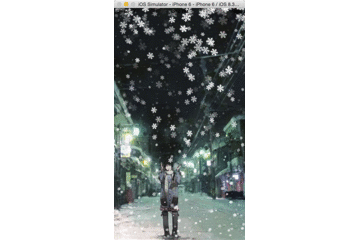iOS实现大雪纷飞动画 iOS实现大雪纷飞动画
桂雏菊 人气:01.结果展示
美丽的雪花,勾起了多少美好的回忆。

2.制作思路
其实创作这样一个大学纷飞的场景是十分简单的,简单到你看了教程之后想不会都不行。OK,下面国际惯例,讲解一下思路吧。
1.创建一个数组用来保存大量的雪花
_imagesArray = [[NSMutableArray alloc] init];
for (int i = 0; i < 1000; ++ i) {
UIImageView *imageView = [[UIImageView alloc] initWithImage:[UIImage imageNamed:@"snow"]];
float x = IMAGE_WIDTH;
imageView.frame = CGRectMake(IMAGE_X, -30, x, x);
imageView.alpha = IMAGE_ALPHA;
[self.view addSubview:imageView];
[_imagesArray addObject:imageView];
}
2.使用时钟(CADisplayLink)来控制下雪,为什么不使用NSTimer呢。其实是可以的,只是(CADisplayLink)刷帧更快一些。
//创建时钟,并且添加到主循环中 CADisplayLink *link = [CADisplayLink displayLinkWithTarget:self selector:@selector(makeSnow)]; [link addToRunLoop:[NSRunLoop mainRunLoop] forMode:NSDefaultRunLoopMode];
3.下雪,就是把数组当做队列来使用。
每次从数组头部取出一个雪花并且删除其在数组中的占位。
让雪花飘落,通过UIView动画完成frame,transform等改变。
当动画完成之后,将取出的雪花再次放进数组的尾部
- (void)makeSnow
{
if (_imagesArray.count > 0) {
UIImageView *imageView = _imagesArray[0];
[_imagesArray removeObjectAtIndex:0];
[self snowFall:imageView];
}
}
- (void)snowFall:(UIImageView *)imageView
{
[UIView animateWithDuration:10 animations:^{
imageView.frame = CGRectMake(imageView.frame.origin.x, Main_Screen_Height, imageView.frame.size.width, imageView.frame.size.height);
imageView.transform = CGAffineTransformMakeScale(0.3, 0.3);
imageView.transform = CGAffineTransformRotate(imageView.transform, M_PI);
} completion:^(BOOL finished) {
float x = IMAGE_WIDTH;
imageView.frame = CGRectMake(IMAGE_X, -30, x, x);
[_imagesArray addObject:imageView];
}];
}
3.有代码有真相
#define IMAGE_X arc4random()%(int)Main_Screen_Width
#define IMAGE_ALPHA ((float)(arc4random()%10))/10
#define IMAGE_WIDTH arc4random()%20 + 10
#define PLUS_HEIGHT Main_Screen_Height/25
#define Main_Screen_Height [[UIScreen mainScreen] bounds].size.height
#define Main_Screen_Width [[UIScreen mainScreen] bounds].size.width
#import "ViewController.h"
@interface ViewController ()
@property (nonatomic ,strong) NSMutableArray *imagesArray;
@property (nonatomic , strong) UIImageView *imageView;
@end
@implementation ViewController
- (void)loadView
{
UIImageView *imageView = [[UIImageView alloc]initWithFrame:[UIScreen mainScreen].bounds];
imageView.image = [UIImage imageNamed:@"backgound.jpg"];
imageView.contentMode = UIViewContentModeScaleAspectFill;
self.view = imageView;
}
- (void)viewDidLoad
{
[super viewDidLoad];
_imagesArray = [[NSMutableArray alloc] init];
for (int i = 0; i < 1000; ++ i) {
UIImageView *imageView = [[UIImageView alloc] initWithImage:[UIImage imageNamed:@"snow"]];
float x = IMAGE_WIDTH;
imageView.frame = CGRectMake(IMAGE_X, -30, x, x);
imageView.alpha = IMAGE_ALPHA;
[self.view addSubview:imageView];
[_imagesArray addObject:imageView];
}
//创建时钟,并且添加到主循环中
CADisplayLink *link = [CADisplayLink displayLinkWithTarget:self selector:@selector(makeSnow)];
[link addToRunLoop:[NSRunLoop mainRunLoop] forMode:NSDefaultRunLoopMode];
}
- (void)makeSnow
{
if (_imagesArray.count > 0) {
UIImageView *imageView = _imagesArray[0];
[_imagesArray removeObjectAtIndex:0];
[self snowFall:imageView];
}
}
- (void)snowFall:(UIImageView *)imageView
{
[UIView animateWithDuration:10 animations:^{
imageView.frame = CGRectMake(imageView.frame.origin.x, Main_Screen_Height, imageView.frame.size.width, imageView.frame.size.height);
imageView.transform = CGAffineTransformMakeScale(0.3, 0.3);
imageView.transform = CGAffineTransformRotate(imageView.transform, M_PI);
} completion:^(BOOL finished) {
float x = IMAGE_WIDTH;
imageView.frame = CGRectMake(IMAGE_X, -30, x, x);
[_imagesArray addObject:imageView];
}];
}
4.Demo也不能少
下载地址:snow
加载全部内容